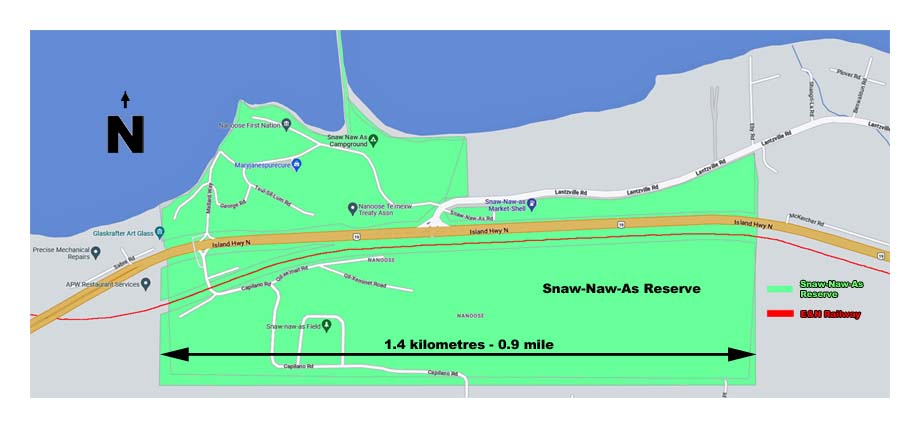Nanoose Vancouver Island British Columbia - The former E&N railway has served its purpose and
now it's time to explore other opportunities instead of spending nearly a billion dollars to repair the line and tens
of millions in annual operating costs, says the chief of the Nanoose First Nation, the same nation that filed a court
case in hopes of winning its land back from the railway right-of-way.
"We are now at the point where there is no business case to re-invest in the corridor," said Snaw-Naw-As
First Nation Chief Gordon Edwards, noting operating and repair costs have been unsustainable for decades.
The line stopped carrying passengers in 2011 because of the poor condition of its tracks.
The federal government has until 14 Mar 2023 to decide whether it will put money into reviving rail service between
Courtenay and Victoria, as a result of a 2021 decision by the B.C. Court of Appeal.
That decision came after the Snaw-Naw-As Nation sought return of land in the corridor's right-of-way that was not being
used for railway purposes any more.
It lost its case, but appealed the decision.
The Court of Appeal set an 18 month deadline for the federal government to decide if it will fund infrastructure
improvements on the corridor.
The right-of-way that cuts through Snaw-Naw-As lands was granted to the former E&N Railway in 1912 to create the
rail line.
Today, the Island Corridor Foundation, made up of regional districts and First Nations, holds the land.
First Nations have expressed concern about the Island Rail Corridor running through or next to their communities and
traditional territories.
"Given the impacts of the corridor on some of these communities, there is limited interest in restoring rail
service in its current location(s)," says a new First Nations engagement report from B.C.'s Ministry of
Transportation and Infrastructure and the Island Corridor Foundation.
The report follows engagement last fall with 14 First Nations, some of which are making plans for alternative use of
lands now held by the Island Corridor Foundation if rail service is not restored.
Some nations are also interested in a joint or partial ownership of a new rail service, the report said.
Under the engagement process, First Nations pointed out the potential to develop parts of the corridor that cross their
communities, but said informal discussions do not meet the Crown's duty to consult.
First Nations cited health and safety concerns if rail service is restored next to their communities, the report
said.
They also warned of possible unintended consequences, including an influx of non-indigenous people within their lands,
impacts on animal-crossing corridors, and flooding.
The engagement process heard from First Nations open to non-rail transportation use because of potential environmental
benefits, but views on the best possible use vary.
Some favoured commuter transit such as light rail or rapid buses to cut back on vehicles on roads, while others want to
see a corridor for cycling and walking.
"However, use of the corridor for bikeways, trails, or other forms of transportation should be secondary to
nations' interests," the report said.
The Capital Regional District and three others on the Island are calling on the government to support
rail.
Edwards, however, called on the Island Corridor Foundation and regional districts to start thinking about what else is
possible for the corridor and "stop pursuing an unsustainable, expensive, Victorian-era
fantasy."
He said regional districts urging Ottawa to fund the rail line "have the gall to say that doing so furthers
reconciliation."
Carla Wilson.
 The E&N Railway has been the backbone of Vancouver Island
since 1912 travelling nearly the length of the Island from Victoria to Courtenay. Should the provincial and
federal governments not act by 14 Mar 2023 the Snaw-Naw-As court case will remove approximately a tiny 1 mile
chunk from the railway right-of-way thereby blocking any future rail traffic, or land use, however the
right-of-way might be developed, north of Nanoose. A terrible loss for what is today's under utilized asset.
The E&N Railway has been the backbone of Vancouver Island
since 1912 travelling nearly the length of the Island from Victoria to Courtenay. Should the provincial and
federal governments not act by 14 Mar 2023 the Snaw-Naw-As court case will remove approximately a tiny 1 mile
chunk from the railway right-of-way thereby blocking any future rail traffic, or land use, however the
right-of-way might be developed, north of Nanoose. A terrible loss for what is today's under utilized asset.
(likely no image with original article)
(usually because it's been seen before)
provisions in Section 29 of the
Canadian Copyright Modernization Act.


